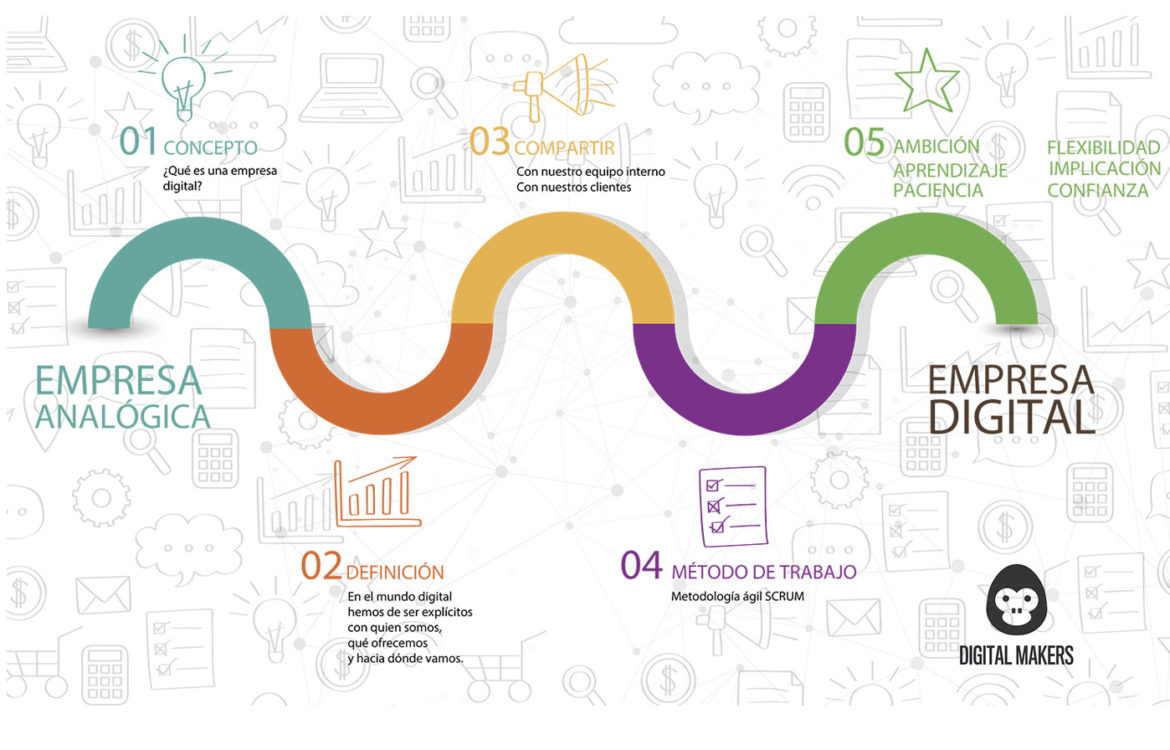Bad news!
No one is able to transform a company digitally by reading a blog!
Good news!
You can manage to transform a company digitally, in a surprisingly radical way, if we put in a bit of daily effort, we get involved and we let ourselves be accompanied by a specialized agency!
Indeed, the digital transformation of a company requires practice and effort. But it is the most relevant learning that a company of the year 2018 can carry out: the passport to survival, and probably the competitive advantage.
At DigitalMakers we have identified the following points as key points for the digital transformation of SMEs:
![]() Concept.
Concept.
Understand what a digital company is.![]() Definition.
Definition.
In the off-line world we could allow ourselves not to define ourselves too much, to go a little bit to everything, without giving up anything. In the digital world, we must be explicit with who we are, what we offer and where we are going. This point can be worked with tools such as vision, mission, business canvas, empathy map and horizons map.
![]() Share.
Share.
This exercise of self-definition should be shared with the whole world actively, starting with our internal team, towards the community of people interested in our services or products. To share it, we must use all possible tools at our disposal, from meetings or face-to-face talks, to webinars, corporate websites, mailings, social networks, etc. No doubt this sharing will help to make a cultural change in our team and with our community that will align us all together with the value we bring to society and with our business objectives.![]() Work method.
Work method.
We must be agile, and not in the sense of light and fast, that also, but in the most solid sense of the agile methodology (for example, scrum or similar). Work iteratively, from less to more, in constant feedback from the community and the human team, contrasting at all times if we are on the right track. Measuring periodically with the metrics that we have defined.![]() Ambition, learning, patience, flexibility, involvement and trust.
Ambition, learning, patience, flexibility, involvement and trust.
These are the adjectives that we at DigitalMakers believe best describe the culture that should prevail in a Digital Transformation project.
Ambition, because in digital you have to think big, not local, or small scale. The investment that involves the digitalization of a company is only justified by working in large volumes;
Learning, all the human team must be continuously open learning and new respects;
Patience, we must not confirm by walking aimlessly and letting the months pass, but we must not want either for yesterday;
Flexibility, we have to keep the mind flexible, to adapt to new ways of understanding the business, to new ways of making decisions;
Implication, the digital transformation of a company is not something that we can outsource and forget as if for example a cleaning service, in which we do not expect to be asked if they have to clean under the tables or what product to use. In a process of digital transformation, the involvement of the entire human team in terms of time and resources, starting with the directive, is absolutely essential;
And finally trust, in a process of digital transformation we have to create a safe environment where all those involved, suppliers, internal, etc. are comfortable to make decisions and make mistakes, while constantly working towards a specific goal, in an iterative improvement process.
With the right guidance, as we offer in DigitalMakers, every company can reach and overcome a process of digital transformation.
At DigitalMakers we are familiar with the usual obstacles encountered by SMEs in digital transformation processes.
Once we have started a process of continuous improvement, without a doubt, we will see how the digital capacity of the company grows. As in the gym, the company will gain strength and flexibility, power and energy!
Such would be a personal fitness trainer:
Let’s put the batteries! Here our best state begins digitally.
Note- Part of the text of this article has been taken from the book “Nada es tan terrible (Nothing is so terrible)” by Rafael Santandreu, where the author proposes a similar process at the time of facing a change in the emotional state of the people.









